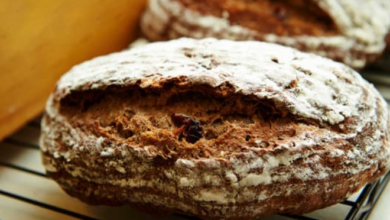Make Rye Bread Without Yeast – It’s Easier Than You Think!

What To Know
- Cover the loaf with a damp cloth and let it rest at room temperature for 1-2 hours, or until it has doubled in size.
- Yeast-free rye bread has a distinct sour flavor due to the presence of lactic acid bacteria in the sourdough starter.
- You can use a sourdough discard (the portion of the starter that is removed before feeding) or a commercial sourdough substitute.
Embark on a culinary adventure with this comprehensive guide to crafting delectable rye bread without the use of yeast. Unleash the secrets of this ancient bread-making technique and savor the unique flavor and texture of rye bread.
Why Make Rye Bread Without Yeast?
- Health Benefits: Rye flour is rich in fiber, vitamins, and minerals, making yeast-free rye bread a nutritious choice.
- Digestibility: The absence of yeast makes rye bread easier to digest for those with yeast sensitivities.
- Flavor and Texture: Yeast-free rye bread has a distinct sour flavor and dense, chewy texture that sets it apart from traditional yeast-based breads.
Ingredients You’ll Need:
- 2 cups rye flour
- 1 cup water
- 1/2 cup sourdough starter
- 1 teaspoon salt
Step-by-Step Instructions:
1. Create the Sourdough Starter
If you don’t have a sourdough starter, you can create one by mixing 1/2 cup rye flour with 1/4 cup water in a jar. Cover loosely and let it sit at room temperature for 5-7 days, feeding it daily with equal parts rye flour and water.
2. Mix the Ingredients
In a large bowl, combine the rye flour, water, sourdough starter, and salt. Mix until a dough forms.
3. Knead the Dough
Turn the dough out onto a lightly floured surface and knead for 5-7 minutes until it becomes smooth and elastic.
4. Shape the Loaf
Shape the dough into a loaf and place it on a baking sheet lined with parchment paper.
5. Score the Bread
Score the top of the loaf with a sharp knife to allow steam to escape during baking.
6. Rest the Bread
Cover the loaf with a damp cloth and let it rest at room temperature for 1-2 hours, or until it has doubled in size.
7. Bake the Bread
Preheat your oven to 450°F (230°C). Bake the bread for 30-35 minutes, or until the crust is golden brown and the internal temperature reaches 210°F (99°C).
8. Cool and Enjoy
Let the bread cool on a wire rack before slicing and serving.
Tips for Success:
- Use a high-quality rye flour for the best flavor and texture.
- If the dough is too sticky, add more rye flour. If it’s too dry, add more water.
- Let the bread rest long enough to allow the sourdough starter to work its magic.
- Bake the bread at a high temperature to create a crispy crust.
Storing Rye Bread Without Yeast
Store your rye bread in an airtight container at room temperature for up to 3 days. For longer storage, freeze the bread for up to 3 months.
Variations:
- Add seeds or nuts to the dough for extra flavor and crunch.
- Use different types of sourdough starters, such as whole wheat or spelt, to create unique flavors.
- Experiment with different baking times and temperatures to find your preferred texture.
The Art of Patience
Making rye bread without yeast requires a bit of patience, but the results are well worth the wait. Allow ample time for the sourdough starter to develop and for the dough to rest and rise.
Embracing the Sour Flavor
Yeast-free rye bread has a distinct sour flavor due to the presence of lactic acid bacteria in the sourdough starter. Embrace this unique characteristic and enjoy the tangy complexity it adds to the bread.
What You Need to Learn
Q: Can I use commercial sourdough starter?
A: Yes, you can use commercial sourdough starter, but it may not be as potent as a homemade starter.
Q: How can I make rye bread without a sourdough starter?
A: You can use a sourdough discard (the portion of the starter that is removed before feeding) or a commercial sourdough substitute.
Q: Is rye bread without yeast healthy?
A: Yes, rye bread without yeast is a nutritious choice due to the high fiber content and absence of added sugars.
Q: How long can I store rye bread without yeast?
A: Rye bread without yeast can be stored at room temperature for up to 3 days or frozen for up to 3 months.
Q: Can I add other ingredients to the dough?
A: Yes, you can add seeds, nuts, or herbs to the dough for extra flavor and texture.





